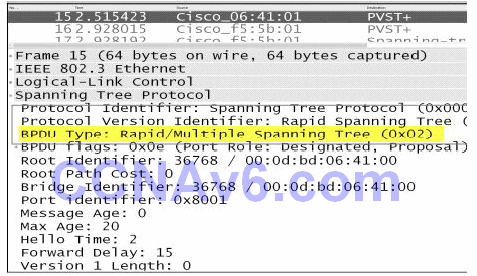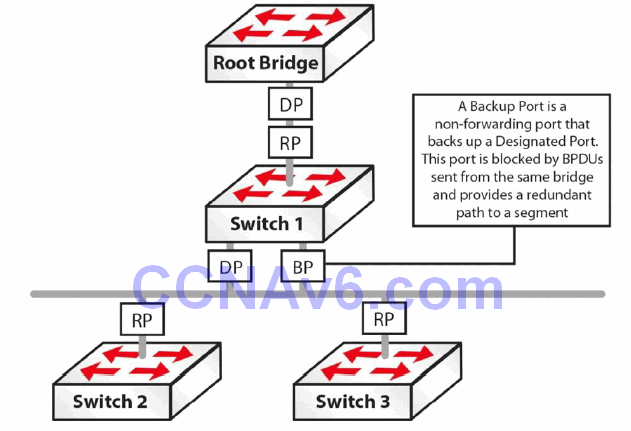Section 32 Tasks
- Read today’s lesson notes (below)
- Review yesterday’s lesson notes
- Complete today’s lab
- Read the ICND2 cram guide
- Spend 15 minutes on the subnetting.org website
The IEEE 802.1D standard was designed at a time when the recovery of connectivity after an outage was within a minute or so, which was considered adequate performance. With the IEEE 802.1D STP, recovery takes around 50 seconds, which includes 20 seconds for the Max Age timer to expire and then an additional 30 seconds for the port to transition from the Blocking state to the Forwarding state.
As computer technology evolved, and networks became more critical, it became apparent that more rapid network convergence was required. Cisco addressed this requirement by developing some proprietary enhancements to STP that include Backbone Fast and Uplink Fast. Today you will learn about the following:
- The need for RSTP
- RSTP configuration
This lesson maps to the following CCNA syllabus requirements:
- Identify enhanced switching technologies
- RSTP
- PVSTP
The Need for RSTP
With the continued evolution of technology, and the amalgamation of routing and switching capabilities on the same physical platform, it soon became apparent that switched network convergence lagged behind that of routing protocols such as OSPF and EIGRP, which are able to provide an alternate path in less time. The 802.1W standard was designed to address this.
The IEEE 802.1W standard, or Rapid Spanning Tree Protocol (RSTP), significantly reduces the time taken for STP to converge when a link failure occurs. With RSTP, network failover to an alternate path or link can occur in a subsecond timeframe. RSTP is an extension of 802.1D that performs functions similar to Uplink Fast and Backbone Fast. RSTP performs better than traditional STP, with no additional configuration. Additionally, RSTP is backward compatible with the original IEEE 802.1D STP standard. It does this by using a modified BPDU, as shown in the screenshot below:

Figure 32.1 – Modified BPDU
RSTP port states can be mapped against STP port states as follows:
- Disabled – Discarding
- Blocking – Discarding
- Listening – Discarding
- Learning – Learning
- Forwarding – Forwarding
RSTP port roles include the following:
- Root (Forwarding state)
- Designated (Forwarding state)
- Alternate (Blocking state)
- Backup (Blocking state)
For the exam it’s very important that you understand the bullet points above, especially which port states forward traffic (once the network is converged). Figures 32.2 and 32.3 illustrate an RSTP Alternate Port and an RSTP Backup Port, respectively:

Figure 32.2 – RSTP Alternate Port

Figure 32.3 – RSTP Backup Port
RSTP with PVST+
Per VLAN Spanning Tree Plus (PVST+) allows for an individual STP instance per VLAN. Traditional or Normal PVST+ mode relies on the use of the older 802.1D STP for switched network convergence in the event of a link failure.
RPVST+
Rapid Per VLAN Spanning Tree Plus (R-PVST+) allows for the use of 802.1W with PVST+. This allows for an individual RSTP instance per VLAN, whilst providing much faster convergence than would be attained with the traditional 802.1D STP. By default, when RSTP is enabled on a Cisco switch, R-PVST+ is enabled on the switch.
Here is a little memory trick you can use to remember the letter designation of the various IEEE STP specification:
- 802.1D (“Classic” Spanning Tree) – It’s dog-gone slow
- 802.1W (Rapid Spanning Tree) – Imagine Elmer Fudd saying “rapid” as “wapid”
- 802.1S (Multiple Spanning Tree) – You add the letter “s” to nouns to make them plural
(multiple) but this is a CCNP SWITCH subject
Configuring RSTP
This can be achieved with one command!
Switch(config)#spanning-tree mode rapid-pvst Switch#show spanning-tree summary Switch is in rapid-pvst mode Root bridge for: VLAN0050, VLAN0060, VLAN0070
Section 32 Questions
- RSTP is not backward compatible with the original IEEE 802.1D STP standard. True or false?
- What are the RSTP port states?
- What are the four RSTP port roles?
- Which command enables RSTP?
- By default, when RSTP is enabled on a Cisco switch, R-PVST+ is enabled on the switch. True or false?
Section 32 Answers
- False.
- Discarding, Learning, and Forwarding.
- Root, Designated, Alernate, and Backup.
- The spanning-tree mode rapid-pvst command.
- True.
Because todays lesson is so short, please do review yesterdays notes again in detail.
Section 32 Lab
RSTP Lab
Topology

Purpose
Learn the configuration command for RSTP.
Walkthrough
1. Check the Spanning Tree mode on your switch.
SwitchA#show spanning-tree summary Switch is in pvst mode Root bridge for: VLAN0002 VLAN0003
2. Change the mode to RSTP and check again.
SwitchA(config)#spanning-tree mode rapid-pvst SwitchA#show spanning-tree summary Switch is in rapid-pvst mode Root bridge for: VLAN0002 VLAN0003
3. Repeat Day 31 (STP) lab using RSTP mode instead.
4. Can you predict which ports will be Root/Designated/Blocking beforehand?
